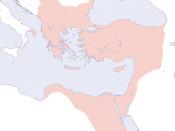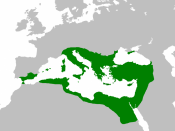The Byzantine Empire followed after the Roman Empire fell. Before the Roman Empire fell, The Byzantine was considered part Eastern Roman Empire which covered the southeast part of Europe, as well as West Asia. The Byzantine Empire began as the city of Byzantium, which had grown from the ancient Greek colony founded on the European side of the Bosporus. The city was then taken in AD 330 by Constantine 1, who re-founded it as Constinople. When Constantine died in 395, Theodosius 1 divided the empire between his two sons. This was starting point at which the Roman Empire fell, and the eastern half continued as the Byzantine Empire with Constinople as the capital.
Two crises between AD 330 and 518 helped shape the Greek part of the empire. The first was the invasion by the Barbarian Huns, Visigoths, and Ostrogoths in the fifth century. Many believe that Constinople averted the fate of Rome, which fell, creating smaller kingdoms in the west.
While the Western Empires was being diminished, the East flourished, and the power now moved primarily to the east.
The second major crisis concerned religion. In the East, religions like Nestorianism and Monophysitism drew on the rich Greek traditions, which clashed with the emerging Roman Catholic Church in the fourth and fifth centuries. Among the challengers was the Eastern branch of the church with Greek as its language, which was closely bound to the political world of Constinople. Soon after these crises, Justinian laid the foundation on which the Byzantine Empire would rest for nearly a century. Justinian was considered an ambitious and dynamic leader. He greatly expanded the empires territory by conquering the southern Levant, northern Africa, and Italy, in an effort to recreate the area of the old Roman Empire. Justinian's administrative reforms created a centralized...


